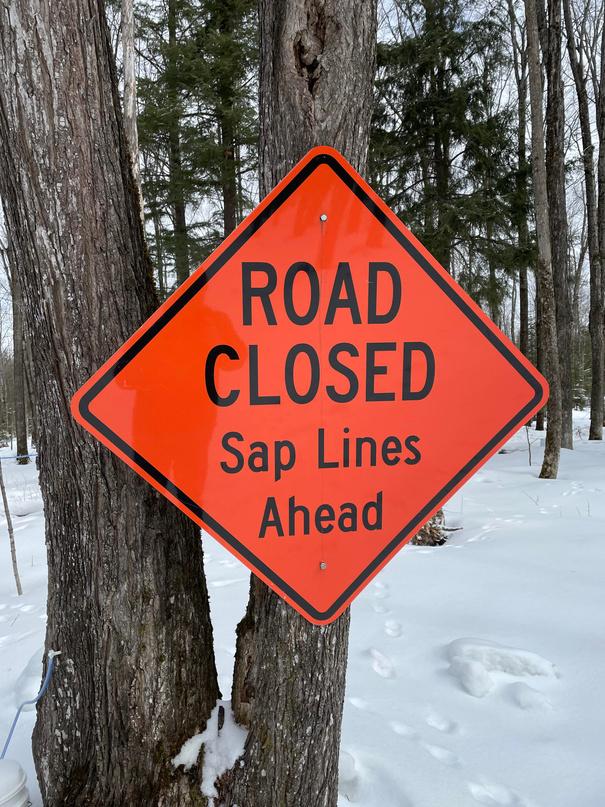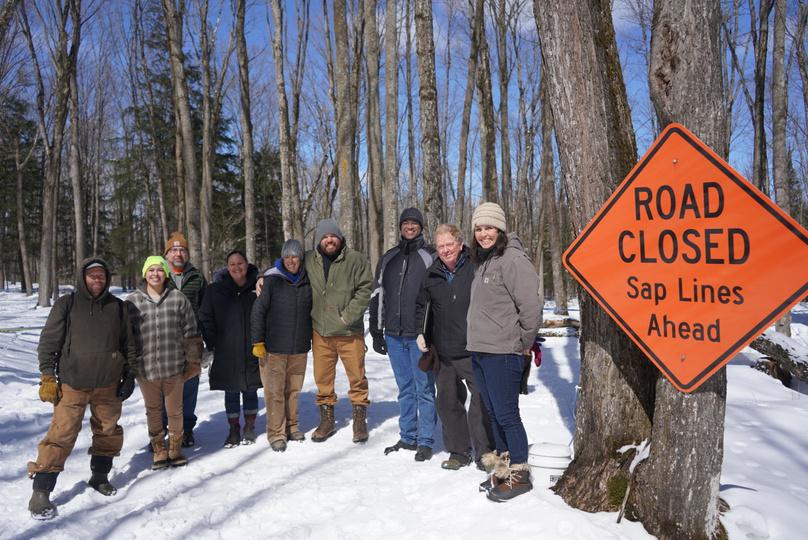
4 minute read
SUGARBUSH
ByJonathanPruitt
As the precipitation shifts between flurries and showers and the temperatures fluctuate below freezing and above, the sap stored deep in the roots of sugar maple trees begins to flow toward the buds of this year's leaves. Following the running sap are the Tribes inWisconsinwhocontinuethepracticeof tapping the sugar maples, collecting the sap, and boiling away the water until it is reduced to syrup or sugar crystals. While the methodology behind processing sap has shifted from kettles and pans over open fires to evaporators with automatic temperature controls, the connection of the Tribes to each other, their lifeways, and their standing relatives through workingthesugarbushtogetherremains. There has been a growing desire among Native American communities to expand sugarbush operations, both through the creation of new operations and increasing production of existing operations. The Wisconsin Natural Resource Conservation Service has recently released an updated document that details how their programs can assist Native American maple sap producers to operate. There are two main avenues through which the NRCS can currently assist sugar bush operations: energy efficiency in boiling sap and forestry assistance for tending to maplestands. On the energy side of things is the EnvironmentalQualityIncentiveProgram (EQIP) Ag Energy Assistance. Starting withanon-farm or in this case sugarbush, energy audit from a Technical Service Provider (TSP) to assess how efficient the existing operation is, EQIP Ag Energy assistance then provides two options to increase efficiency. The first is a reverse osmosis heater to remove water from the sap and the second is an enhanced pre-heater that warms the sap before it reaches the evaporator so that more heat isn’t wasted bringing the evaporator back up to the proper temperature after adding cold sap. While the reverse osmosis heater is better suited for large-scale commercial production, enhanced preheaters are an excellent option for small and medium-sized producers. Currently, TSPs for energy audits in Wisconsin have little familiarity with energy systems for sugarbush operations, but NRCS is working on changing that. Additionally, the NRCS offers cost-sharing for TSPs to perform energy audits through a reimbursementprogram. On the forestry side of things, there are programs through EQIP as well as the Conservation Stewardship Program to improveandmaintainthehealth of maple stands. EQIP offers assistance with creating a forestry management plan through Conservation Planning Activity (formerly CAP) CPA-106 as well as Conservation Practice Standards (CPS) associated with management such as tree marking and thinning through Timber Stand Improvement (CPS 666) and removal of invasive species through Brush Management (CPS 314). Updates to CPSs related to sugarbush operations include Forest Landings and Trails (CPS 655) and Forest Access Roads (CPS 560). Both practices focus on facilitating vehicle access to trees within a maple stand for people to tap trees, set up, and collect sap from buckets and tanks while limiting the effects of vehicle traffic on soils and the tree roots beneath them. CPS 655 is geared toward off-road vehicle traffic like ATVs and skidders, while CPS 560 is gearedtowardheavyusevehicle traffic like trucks. It’s worth noting these practices are intended to address resource concernsresultingfromforestryrelated activities like collecting sap and not for creating recreationaltrails.
Advertisement
Going a step beyond better roads and trails to support forest health, as well as reduce labor and fuel costs for vehicle operations related to hauling sap, are vacuum tubingsystemslinkingmultipletappedtreestomainlines that can drain into storage tanks throughout the stand or directly to where the sap is being processed. While vacuum tubing systems can greatly reduce the need for vehicle traffic in maple stands during a time of year when it’s easy to make ruts in soggy soil, there are some concerns about the effects of the tubing system on tree health. Having multiple trees being tapped with exposed inner bark while also connected via tubes raises the possibility of increased transmission of pests and disease between trees. While more work needs to be done to study the effects of tubing systems, some tribal producers are already operating with vacuum tubing systemsintheirsugarbush.DynamiteHillFarms,whichis based in the UP town of L’Anse, MI, has a mix of trees tapped with individual buckets and groups of trees tapped and connected with tubes. Owners and operators Jerry Jondreau of the Keweenaw Bay Indian Community and Katy Bresette of the Red Cliff Band of Lake Superior Ojibwe, are monitoring the trees in their stands to see if there are differences in health between tubed and non-tubed trees over time. At this time, there are no existing CPS scenarios under which the NRCS can cost-share for vacuum tubing systems for collecting maple sap. However, there can be clear benefits to soil health and plant health from reducing vehicle traffic for sap collection in the forest that comes with utilizing such a system. And while it will take a few years to get the ball rolling on developing an EQIP practice standardandcost-sharingforimplementingtubingsystems for collecting maple sap, efforts are underway to explore this option. If a time comes in the future where the NRCS can support sugarbush operations by helping pay for vacuum tube lines, don’t be surprised when signs like these becomeacommonsightintheforests.

TribalSugarbushWorkshopatDynamiteHillFarms,KeweenawBayIndianCommunity PhotoCredit:DanCornelius







